New kind of bhakti
- Books Name
- Social Science Book
- Publication
- Cognizance Publication
- Course
- CBSE Class 7
- Subject
- Social Science
Chapter 7
Devotional Paths to Divine
Since the eighteenth century, the legacy of various kinds of bhakti and sufi movements have evolved.
The idea of a Supreme God
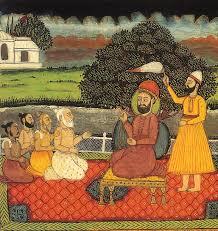
Before the existence of large kingdoms, different groups of people worshipped their own gods and goddesses.The belief that social privileges came from birth in a ‘noble’ family or a high caste was the subject of many learned texts.Many people were uneasy with such ideas and turn to the teachings of Buddha aur Jainas according to which it was possible to overcome social differences and break the cycle of rebirth through personal effort.Others felt attracted to the idea of a Supreme God who could deliver humans from such bondage if approached with devotion (or bhakti).This idea advocated in the Bhagavadgita, grew in popularity in the early centuries of the Common Era.Gods and goddesses worshipped in different areas came to be identified with Shiva, Vishnu or Durga.In the process, local myths and legends become a part of the Puranic stories and methods of worship recommended in the Puranas were introduced into the local cults.They become so popular that even Buddhists and Jainas adopted these beliefs.
New kind of bhakti
New kind of Bhakti in South India-
Nayanars and Alvars
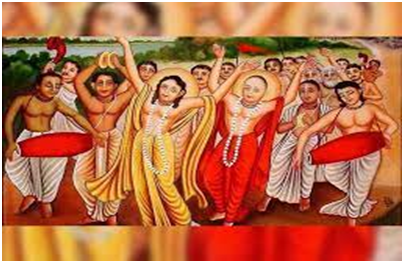
Philosophy and bhakti
Shankaracharya
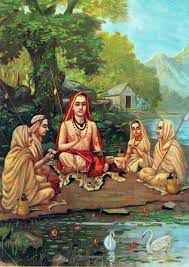
Shankara,one of the most influential philosophers of India was born in Karela in the 8th century.He was an advocate of Advaita or the doctrine of oneness of individual soul and the Supreme God, which is the ultimate reality. He taught that Brahman, the only or ultimate reality, was formless and without any attributes. He considered the world around us to be an illusionor maya, and preachedrenunciation of the world and adoption of the path of knowledge to understand the true nature of Brahman and attain salvation.
Ramanuja, born in Tamil Nadu in the 11th century was deeply influenced by the Alvars. According to him, the best means of attaining salvation was through intense devotion to Vishnu.
Basavanna’s Virashaivism
Virashaiva movement initiated by Basavanna and his companions like Allama Prabhu and Akkamahadevi.This movement began in Karnataka in the mid twelfth-century. The Virashaivas argued strongly for the equality of all human beings and against Brahmanical ideas about caste and the treatment of women.They were also against all forms of ritual and idol worship.
The Saints
From the 13th to the 17th century, Maharashtra saw great number of saint-poets who song in simple Marathi continues to inspire people. The most important among them were Dnyaneshwar(Gyaneshwar), Namdev, Eknath, and Tukaram as well as women like Sakhubai and the family of Chokhamela, who belonged to the ‘untouchable’ Mahar caste.This religious tradition of Bhakti focus on the Vitthala(a form of Vishnu) temple in Pandharpur as well as on the notion of personal God residing in the hearts of all people.These saintt rejected all forms of ritualism,outward display of piety and social differences based on birth.In fact, they rejected the idea of renunciation and prefer to live with their families, earning their livelihood like any other person. A newhumanist idea emerged as they insisted the bhakti lay in sharing others pain as the famous Gujarati saint Narsi Mehta said“They are Vaishnavas who understand the pain of others.”
Social order
- Books Name
- Social Science Book
- Publication
- Cognizance Publication
- Course
- CBSE Class 7
- Subject
- Social Science
Social order
Nathpanthis, Siddhas and Yogis
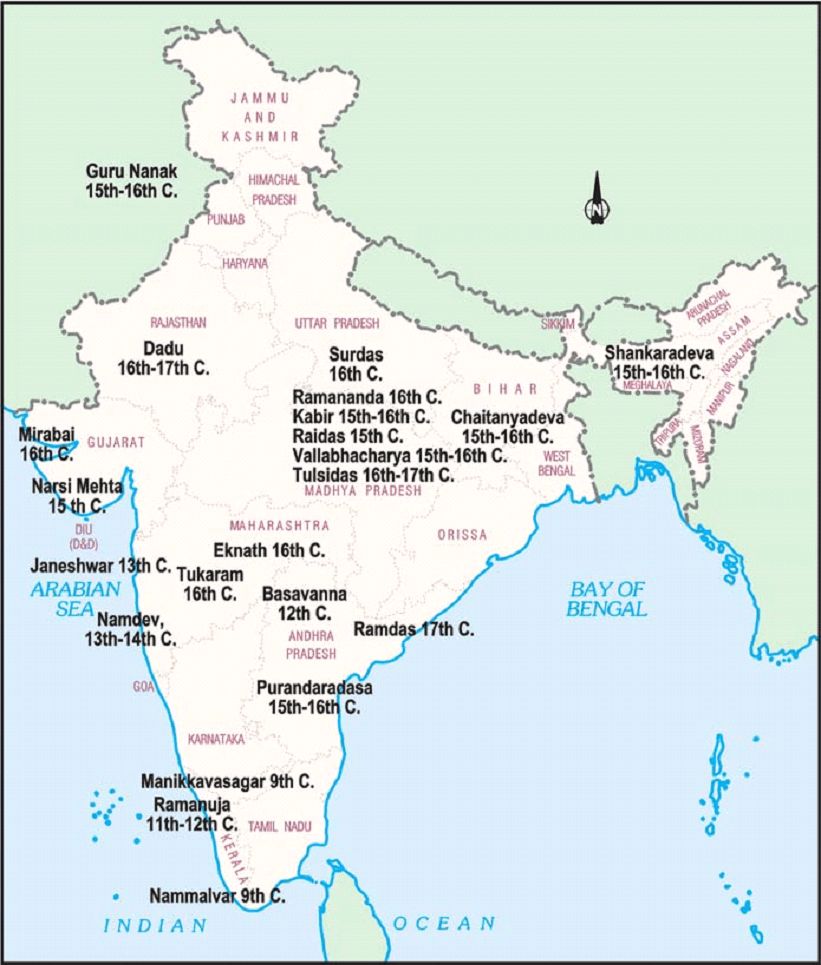
Number of religious groups that emerged during this period criticise the rituals and other aspects of conventional religion and the social order, using simple logical arguments.Among them were Nathpanthis, Siddhacharas and Yogis.They advocated renunciation of the world. To them, the path to salvation lay in meditation on the formless, ultimate reality, and the realisation of oneness.To achieve this, they advocated intense training of the mind and body through practices of yogasana, breathing exercises and meditation. These groups became particularly popular among low castes.
Islam and Sufism
Sufis and Muslim mystics who rejected outward religiousity and emphasised love and devotion to God and compassion towards all fellow human beings.Islam propagated strict monotheism or submission to one God.In the eighth and ninth centuries religious scholars developed different aspects of the Holy Law and theology of Islam. The sufis often rejected the elaborate rituals and codes of behaviour demanded by Muslim religious scholars. Like the saint-poets, the Sufis to composed poems expressing their feelings, and a rich literature in prose, including anecdotes and fables.Among the great Sufis of Central Asia were Ghazzali, Rumi and Sadi. Like the Nathpanthis ,Siddhas and Yogis, the Sufis do believe that the heart can be trained to look at the world in a different way. They developed elaborated method of training using zikr(chanting of a name of sacred formula), contemplation, sama(singing),raqs(dancing), discussion of parables, breath control, etc. Under the guidance of a master or pir.Thus emerged the silsilas, a spiritual genealogy of Sufi teachers each following a slightly different method (tariqa) of instruction and ritual practice. A large number of Sufis from Central Asia settled in Hindustan from the eleventh century onwards.Silsila was among the most influential orders. It had a long line of teachers like Khwaja Muinuddin Chishti of Ajmer, Qutubuddin Bakhtiar Kaki of Delhi, Baba Farid of Punjab, Khwaja Nizamuddin Auliya of Delhi, and Bandanawaz Gisudaraz of Gulbarga.
The Sufi masters held their assemblies in their khanqahs or hospices. Devotees of all description, including members of the royalty, nobility and ordinary people, flocked to these Khanqahs. They discussed spiritual matters, sort the blessings of the saint in solving their problems or attended the music and dance sessions. The Tomb or dargah of a Sufi saint, became a place of pilgrimage to which thousands of people of all faiths thronged.
In Kashmir, the Rishi order of Sufism flourished in the 15th and 16th centuries. This order was established by Sheikh Nuruddin Wali also known as Nund Rishi, or had a deep impact on the life of people in Kashmir. A number of shrines dedicated to Rishi saint can be found in many parts of Kashmir.
New kind of bhakti
- Books Name
- Social Science Book
- Publication
- Cognizance Publication
- Course
- CBSE Class 7
- Subject
- Social Science
New Kind of Bhakti
New religious developments in North India
The period after the thirteenth century saw a new wave of the bhakti movement in north india.This was an age when Islam, Brahmanical Hinduism, Sufism, various strands of bhakti and the Nathpanths, Siddhas andYogis influenced one another.People, especially craftspersons, peasants, traders and labourers,thronged to listen to these new Saints and spread their ideas.Some of them like Kabir and Baba Guru Nanak rejected all orthodox religions.Others, like Tulsidas and Surdas, accepted existing beliefs and practices, but wanted to make these accessible to all.Tulsidas conceived of God in the form of Rama. Tulsidas’s, composition the Ramcharitmanas, written in Awadhi, is important both as an expression of his devotion and as literary work.Surdas was an ardent devotee of Krishna. His compositions compiled in the Sursagara,Surasaravali and Sahitya Lahari,express his devotion.Also contemporary was Shankerdeva of Assam, who emphasised devotion to Vishnu and composed poems and plays in Assamese. He began the practice of setting up namgarhs or houses of recitation and prayer, practice that continues to date. This tradition also included saints like Dadu Dayal, Ravidas and Mirabai.
Meerabai
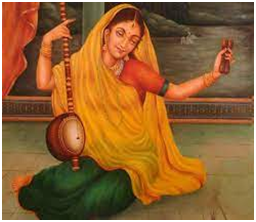
Meerabai was a Rajput Princess, married with the royal family of Mewar in the sixteenth century.She was devoted to Krishna and composed innumerable bhajans, expressing her intense devotion.Her songs openly challenge the norms of the upper caste and became popular with the masses in Rajasthan and Gujarat.
A unique feature of most of the saints is that their works were composed in regional languages and could be sung. They became immensly popular and were handed down orally from generation to generation.An important contribution of Bhakti Saints was towards the development of music.Jayadeva of Bengal, composed the Gita Govinda in Sanskrit,each song composed in a particular raga and tala. A significant impact that these saints had on music was the use of bhajan, kirtan and abhang. These songs, which emphasised on emotional experience, had a tremendous appeal to the common people.
Kabir
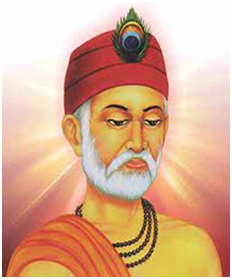
Kabir, who probably lived in the fifteenth-sixteenth centuries, was one of the most influential saints.He was brought up in a family of Muslim julahas and weavers settled in or near the city of Banaras.He composed vast collection of versus called sakhis and pads which was sung by wondering bhajan singers.Some of these were later collected and preserved in the Guru Granth Sahib, Panchvani and Bijak.His teachings openly ridiculed all forms of external worship of both Brahmanical Hinduism and Islam.The language of his poetry was a form of spoken Hindi, widely understood by ordinary people.He also sometime use cryptic language, which is difficult to follow.Kabir believed in a formulessSupreme God and preached, that the only path to salvation was through bhakti or devotion. Kabir drew his followers from among both Hindus and Muslims.
Baba Guru Nanak
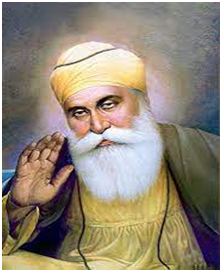
Baba Guru Nanak(1469-1539) Born at Talwandi and travelled widely before establishing a centre at Kartarpur( Dera Baba Nanak on the river Ravi).A regular worship that considered of the singing of his own hymns was established there for his followers. Irrespective of their former creed, caste or gender, his followers ate together in the common kitchen (langar).The sacred space thus created by Baba Guru Nanak was known as dharamsal. It is now known as Gurudwara.Before his death in 1539, Baba Guru Nanak appointed one of his followers as his successor, known as Guru Angad.Guru Angad compiled the compositions of Baba Guru Nanak, to which he added his own in a new script known as Gurmukhi.
The three successors of Guru Angad also wrote under the name of ‘Nanak’ and all of their compilations were compiled by Guru Arjan in 1604. This compilation was authenticated by Guru Teg Bahadur’s son and successor Guru Gobind Singh in 1706. It is now known as Guru Granth Sahib, the Holy Scripture of the Sikhs.Baba Guru Nanak’s followers increased through the sixteenth century under his successors.They belonged to a number of castes but traders, agriculturists, artisans and craftsman predominated. In seventeenth century the town of Ramdaspur(Amritsar) had developed around the central Gurudwara called Harmandar Sahib (Golden Temple).
Golden Temple(Amritsar)
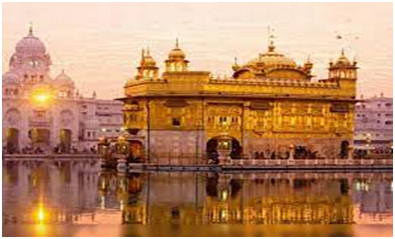
It was virtually self governing in modern historians refer to the early 17th century, Sikh community as ‘a state within the state’.The Sikh movement began to get politicised in the seventeenth century, a development which culminated in the institution of Khalsa by Guru Gobind Singh in 1699.The community of the sikhs called the Khalsa Panth, became the political entity.Guru Nanak emphasise the importance of worship of one God.He insisted that caste, creed or gender was irrelevant for attaining liberation. He himself used the term nam, dan and isnan for the essence of his teaching, which meant right worship, welfare of others and purity of conduct.His teachings are now remembered as nam-japna, kirt-karna, and vand-chhakna, which also underline the importance of right belief and worship, honest living and helping others.Thus, Baba Guru Nanak idea of equality has social and political implications.

 Cognizance Publication
Cognizance Publication
